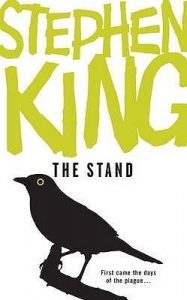
What I learned from… ‘The Stand’ by Stephen King
 About the book
About the book
The Stand begins with the accidental release of a deadly flu virus from a government laboratory, which quickly spreads and wipes out most of the world’s population. Those who are left behind find themselves divided into two groups: one led by the benevolent Mother Abagail, who represents the forces of good, and another led by the enigmatic Randall Flagg, who embodies evil.
As these two groups form and gather followers, a battle between good and evil unfolds in the ruins of society. The survivors must confront their inner demons and make difficult choices as they navigate the dangers of this new world. The Stand explores themes of morality, faith, and the resilience of the human spirit in the face of a catastrophic event. It’s a gripping and epic tale of survival, the clash between light and darkness, and the quest to rebuild civilization in the wake of a devastating pandemic.
What I learned
Well, it’s long. Incredibly long. Dauntingly so. But from the first page, King draws the reader in, and starts building a terrible sense of foreboding that only increases over the course of the book. This edition has extra material, but not having read any earlier edition, I’m not sure which parts King has expanded on here.
The book is incredibly rich with a huge cast of characters; each one full and alive, and all their storylines handled by a close omniscient narrator. We follow each of them on what feels like a fated journey (unless they succumb to the virus / apocalypse / evil of Randall Flagg on the way – spoiler: a lot of them do). The narrative can be broken into three phases: the world before the virus hits, the world of the survivors on the move, and the ‘kingdoms’ of Mother Abigail and Randall Flagg. In the first phase, I thought I was reading a standard-issue post-apocalyptic thriller, but when the second phase began, I realised it was anything but.
What struck me most about the book was the way King increases the sense of the otherworldly till the reader can’t work out what is real and unreal. It starts with the dreams the characters have, then seemingly supernatural occurrences like the mysterious (and inexplicable) visit of The Walking Dude to the jail. I read and re-read that scene feeling I’d missed something. It didn’t make sense in the world of the story to that point. But then I realised that was the point. King unmoors the reader from the reality he’s already set up. From then on, I had no idea where he was taking the story, or what the new rules of this world were, but I knew I wanted to find out.
The use of the supernatural is most obvious in Randall Flagg as a de facto devil in the post-virus world. Some of the description of him have stayed with me long after finishing the book. The sex scene with Nadine in particular was horrific and the stand-out moment of the book for me. This description of him in the epilogue is particularly chilling (given what’s come before):
That smile was like a red sun breaking through a black cloud.
It exposed bright white teeth and amazing blazing eyes. He turned his lineless palms out to face them in the universal gesture of peace.
Before the force of that grin they were lost.
I haven’t yet written anything using an omniscient narrator, but King here shows how it can be done to create a genuinely immersive, sweeping epic, zooming into characters’ interior lives, while also neatly dealing with the trifling matter of the fate of the planet.
More about this book
This edition published in 2007 by Hodder and Stoughton
The Stand at Hodder and Stoughton
About ‘What I learned…’
 About the book
About the book